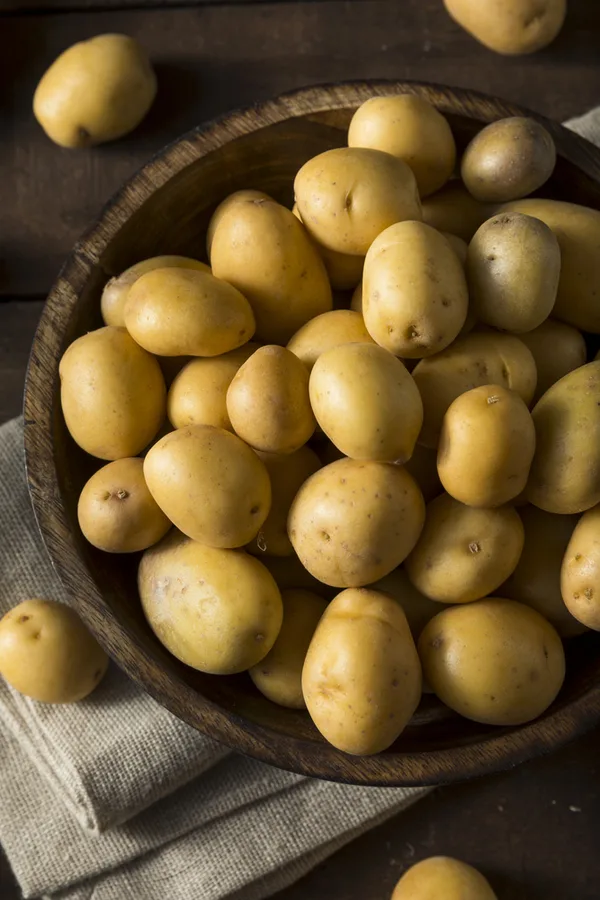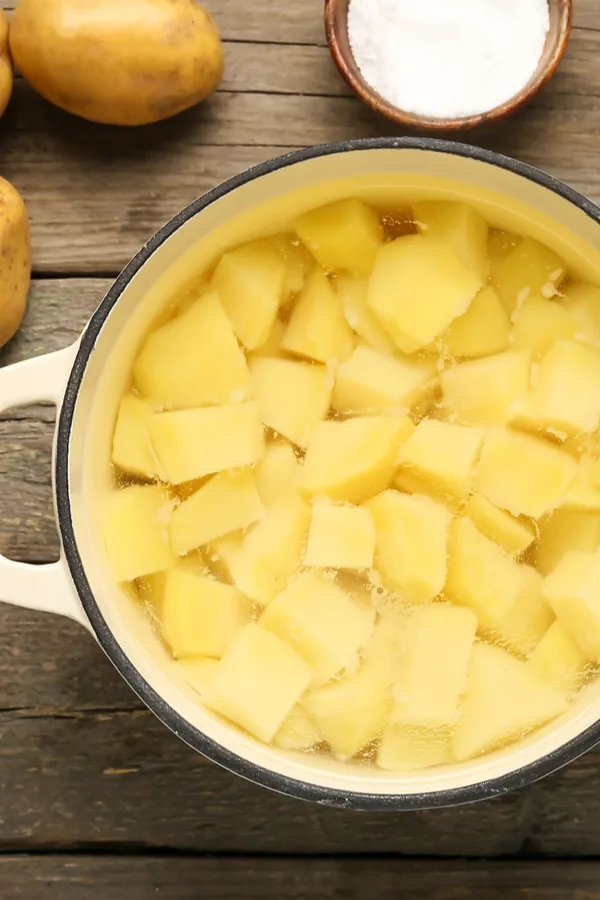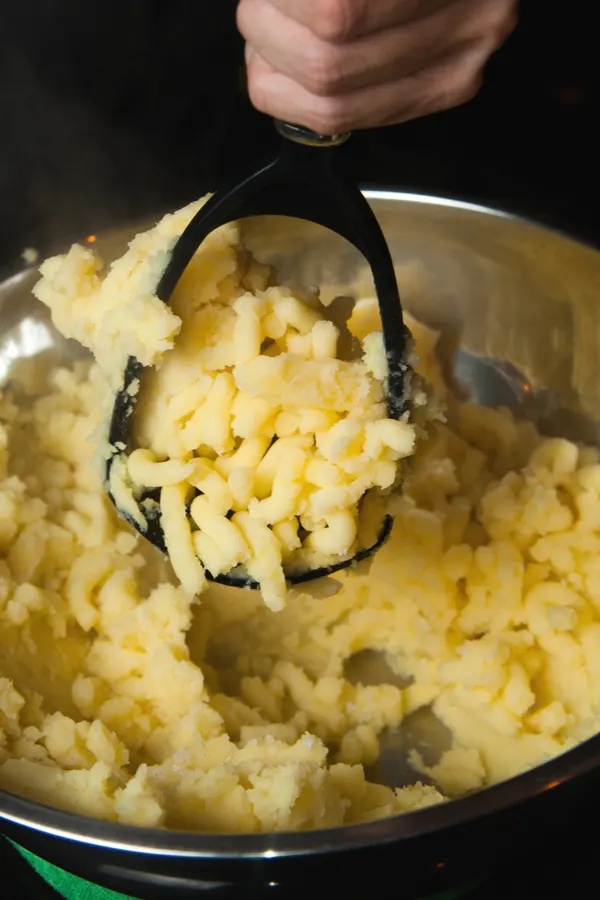When you go to make your holiday dinner this year, be sure to follow the tips, tricks and the recipe below to make the Best Mashed Potatoes that you have ever had! Light and fluffy mashed potatoes that are creamy, delicious and have a smooth, buttery texture.
It is one of the most common side dishes served at holiday dinners, including Thanksgiving. And there is nothing like taking a bite of mashed potatoes that are perfectly cooked, especially when they melt in your mouth.
However, there is nothing more disappointing when the opposite happens. It takes everything you have to swallow that unexpected bite of lumpy, paste like spoonful of potatoes.

But luckily, getting the perfect consistency of this classic side dish is easy to achieve. By following just a few simple steps you can avoid the pitfalls that lead to those unappetizing potatoes, which in the end, will make everyone at the table happy!
Why Mashed Potatoes Turn Out Gluey
We have all seen or have tasted mashed potatoes that are flat, watery and gluey. So why do they turn out this way?
When potatoes are boiled and then mashed, they release starch. The more that you work the potatoes, the more the starch gets released.
The excess starch then turns the potatoes into an unpleasant gummy texture when being mixed.
However, there are a few tips and tricks that you can use to prevent this from happening.
The most often overlooked culprit to potatoes that turn out flat and ‘gooey’ is a result of too much starchy water left in the potatoes before mashing them. Therefore, the key is to get as much moisture out of your potatoes as you can before mashing them.
Ironic when you just spent 20 minutes boiling them in water, isn’t it?
However, after the potatoes are boiled and drained, add them back to the hot pot. Then cook the tender diced potatoes for a few minutes on low heat. This allows the extra water to release from the potatoes, resulting in the best mashed potatoes that you have ever had!
Although, it also helps to pick out the best variety of potato as well. And it really does make a huge difference in the end result.

What Potatoes Are Best For Making Mashed Potatoes
Russet Potatoes: These are starchy potatoes that have a high starch content and low water ratio. They are great for baking, making French fries, and good for making light and fluffy mashed potatoes.
Yukon Gold Potatoes: They are considered the all-purpose potato and have medium starch and medium water content. These potatoes are great in stews, soups, mashed potatoes, or for roasting. When cooked, they become moist and fluffy and have a slight butter flavor.
Although the Russet potatoes, when cooked properly will give you the fluffiest texture, I prefer to use Yukon gold potatoes. The mashed texture is slightly more dense, however the added flavor is well worth it!
Just be sure to avoid waxy potatoes such as new, red or fingerling potatoes. Although Creamy Red Skin Mashed Potatoes are delicious, they won’t turn out light and airy.
The Best Mashed Potato Recipe
*Complete recipe instructions including specific measurements, cook temperatures and times are located in a printable recipe card at the bottom of this article. However, be sure to keep reading for helpful tips and tricks when making this recipe.
Ingredients:
- 5 lbs of potatoes, Russet or Yukon Gold
- 2 teaspoons salt
- 4 tablespoons of butter
- 1/2 – 3/4 cup of whole milk or half-and-half
- additional salt and pepper to taste
It may surprise you, however those are the only ingredients required to make the best mashed potatoes that you have ever had. No fancy ingredients and no special seasonings.
I am talking standard, old-fashioned potatoes like Grandma used to make.

INSTRUCTIONS
The first step, and one of the most important things that you can do when making mashed potatoes, is to take the milk and butter out of the refrigerator before you begin.
You want those two ingredients to be near room temperature when you add them to the cooked potatoes. This will help the liquid absorb into the potatoes, preventing the need to over mix.
In fact, some people recommend heating both the milk and butter before mixing. Although, if both the ingredients are at room temperature I have found that it works just as well, and it is one less dish to wash at the end of the day!
While your milk and butter are sitting on the counter, it is time to prepare the potatoes. Start by scrubbing the potatoes to remove any dirt or eyes that are beginning to form.
Then use a good vegetable peeler to remove the skins. *Although there are many people that prefer to leave the skins intact, I find it increases the time require to mash the potatoes and skins together after they have been cooked. This in turn results in that unpleasant gooey texture that we talked about earlier.
When the potatoes are p, give them one final rinse under cold water. Then use a sharp knife to dice the potatoes in uniform size pieces.
Although you can cut the potatoes in half, fourths, or in several sections, just remember that the smaller the cubes, the faster they will cook.
Therefore, I typically cut the potatoes in 1 inch cubes. Now place the cubed potatoes in a large stock pot and add enough cold water to cover 1/2 inch above the top layer.
Cook Time
Place the pot over medium-high heat and add salt. Bring the pot to a boil and continue to cook at a rolling boil for approximately 20 minutes. The potatoes are ready when a fork can easily pierce through the center of the potatoes.
However, be sure to check several potatoes throughout the pot to check for doneness before removing them from the heat.
Carefully drain the cooked potatoes into a large colander. Then return the potatoes to the pot on low heat for approximately 5 minutes to allow the moisture to escape.
You should hear sizzling and you will notice that the potatoes will begin to stick to the bottom of the pot. Lightly toss the potatoes so that the ones on top have a chance to release the liquid on the hot surface as well.
Mashing The Potatoes
Now it is time to make the magic happen! Use a potato masher to smash the potatoes. I prefer the nylon potato masher with the holes in the center, rather than the squiggly metal variety. This way I don’t have to worry about damaging my non-stick cookware.
Although I used to use a hand mixer, in order to make the BEST mashed potatoes it really is better to use a unmotorized potato masher or ricer.
This is because it is very easy to over mix using a hand or stand mixer. Therefore, if you do choose this route for mashing, take extra caution not to over mix!
As the potatoes begin to break down add the room temperature butter and a little milk at a time and continue to mash.
Continue to add the milk until you have the consistency that you want. Add salt and pepper to taste and fold the seasonings in using a silicone spatula rather than continuing to use the potato masher.
Transfer to a serving bowl and top with sliced butter pads as desired.
There it is, the best way to make mouth-watering light and fluffy mashed potatoes!
Enjoy!
Mary and Jim

Jim and Mary Competti have been writing gardening, DIY and recipe articles and books for over 15 years from their 46 acre Ohio farm. The two are frequent speakers on all things gardening and love to travel in their spare time.
As always, feel free to email us at thefarm@owgarden.com with comments, questions, or to simply say hello! You can sign up for our free email list in the subscribe now box in the middle of this article. Follow us on Facebook here : OWG Facebook. This article may contain affiliate links.
Light and Fluffy Mashed Potatoes

How to make light and fluffy mashed potatoes. The keys to getting the perfect texture, including the type of potato that is best to use and the correct cooking techniques.
Ingredients
- 5 lbs of potatoes, Russet or Yukon Gold
- 2 teaspoons salt
- 4 tablespoons of butter
- 1/2 - 3/4 cup of whole milk or half-and-half
- additional salt and pepper to taste
Instructions
*Before you start, take the milk and butter out of the refrigerator to take the chill off of it.
- Wash and peel the potatoes.
- Dice potatoes in uniformed sized pieces - the smaller the cubes, the faster they will cook and place into a large stock pot.
- Cover potatoes with water and add 2 teaspoons of salt. Boil for approximately 20 minutes until fork tender.
- Drain potatoes and return to the pot on low heat for approximately 5 minutes to allow the moisture to escape.
- Begin to mash potatoes - either with a potato masher or with an electric mixer.
- Add butter, continue to mash.
- Add milk a little at a time and continue to mash. Continue to add until you have the consistency that you want. **If you are using a mixer, remember to scrape down the sides of the bowl to prevent lumps but don't over mix.
- Use a silicone spatula to add seasonings/spices as desired.
Notes
The key to light and fluffy mashed potatoes is to remove the excess moisture after the potatoes are cooked and to not over mix when mashing.
Recipe courtesy of Old World Garden Farms
Nutrition Information:
Yield:
12Serving Size:
1 gramsAmount Per Serving: Calories: 227Total Fat: 4gSaturated Fat: 3gTrans Fat: 0gUnsaturated Fat: 1gCholesterol: 11mgSodium: 432mgCarbohydrates: 43gFiber: 4gSugar: 3gProtein: 5g
Nutritional Information is to be used as a general guideline only . Nutritional calculations will vary from the types and brands of the products used.


